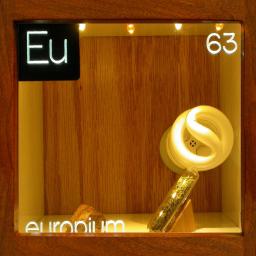Home Size: 1 2 3 4 5 6 7 8 9
|
 |
| A soft, silvery metal that is the most reactive member of the lanthanide group. It is used to produce phosphors for lights and TV screens.
|
|
|
 |
Lumps ampouled under argon.
Europium is a tricky metal to present in a periodic table collection. Of all the lanthanides, it is the most sensitive to atmospheric exposure and tarnishes easily and rapidly. Even fresh europium metal direct from the producers has a surface layer of oxide which results in a characteristic iridescent sheen. Although the sample here has started to spall (see the powder at the bottom of the ampoule), it will hopefully act as its own getter and consume all the gas with which it can react reaching a stable state.
Source: China
Size: 1.5"
Purity: 99.9%
|
|
 |
Compact fluorescent bulb.
The main industrial use for europium is as a key ingredient in phosphors for lamps and TV screens. It can produce both red and blue light, depending on the oxidation state in the compound (usually an oxide) used. In the new long-life low-energy compact fluorescents, europium is responsible for the pleasant warmer color of the light. A mixture of europium compounds are coated onto the interior surface of the lamp and stimulated to glow by discharge through the low pressure gas in the tube.
Source: hardware store
Size: 4"
Purity: n/a
|
|
 |
Monazite.
The rare earth elements (REE) are a homogenous group of elements, usually occurring together in nature. Four of the rare earths, europium, lutetium, terbium and thulium do not occur as part of the chemical formulae of any mineral but only as minor impurities in other REE minerals. Nevertheless, the quantities present are extractable and represent the only viable sources of these elements. Amongst the rare earths, only promethium is not associated with monazite, due to the short half lives of all of its isotopes.
Source: Mackay mineral collection
Size: 1"
Purity: 5%
|
|
|

